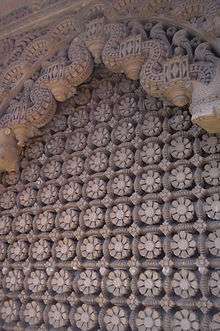Dhoraji
Dhoraji (![]()
Dhoraji | |
|---|---|
City | |
Three Gates (Tran Darwaja), Dhoraji | |
 Dhoraji Location in Gujarat, India | |
| Coordinates: 21.73367°N 70.449915°E | |
| Country | India |
| State | Gujarat |
| District | Rajkot |
| Elevation | 73 m (240 ft) |
| Population (2014) | |
| • Total | 84,545 |
| Languages | |
| • Official | Gujarati, Hindi |
| Time zone | UTC+5:30 (IST) |
| PIN | 360410 |
| Telephone code | +912824 |
| Vehicle registration | GJ 03 |

History
Dhoraji was acquired by Kumbhaji II of Gondal State from Junagadh State about the middle of the eighteenth century.[1] Sir Bhagwatsinhji, the noble ruler of Gondal State, was born at Dhoraji Darbargadh. He established a town planning department and in the late 19th century introduced town planning principles to regularize and monitor the growth of the fortified towns of Gondal, Dhoraji and Upleta and Patanvav.
With the arrival of the railway, a new part of the Dhoraji town, between the railway station and the old town, was designed using axial planning, having broad avenues, road junctions, parks, bazaars and public buildings, it is a good example of urban planning of an Indian town during the British Raj.[2]
Attractions
Next to the temples of Shri Panchnath Mahadev, Rushiwadi Bileshwar Mahadev and Shri Chetaniya Hanuman, Shree Swaminarayan Mandir is also a popular spiritual centre in the old town. Murli Manohar Temple located is older than 350 years, bearing various architectural styles like Gujarati ornamental, Rajasthani and Indo-mughal styles.
Ghar Ni Dhoraji Fort was completed in 1755 AD. The massive fort wall has several bastions, 4 main gates and 3 smaller gates, known as baris. The four main gates are Kathiawadi Darwaja in the East, Porbandar Gate in the West, Halar Gate in the North and Junagadh Gate in the South.
Demographics
As of 2001 India census,[3] Dhoraji had a population of 80,807. Males constitute 51% of the population and females 49%. Dhoraji has an average literacy rate of 71%, higher than the national average of 59.5%: male literacy is 78% and, female literacy is 65%. In Dhoraji, 11% of the population is under 6 years of age.
Transport
Road
Dhoraji is on National Highway 27. NH27 connects Dhoraji with Upleta, Rajkot, Porbandar, Gondal and Jetpur. National Highway 927D connects Dhoraji to Jamnagar via Kalavad.
Railway
Dhoraji railway station lies on the Wansjaliya-Jetalsar railway line that connects with Rajkot, the nearest large city. Wansjaliya railway junction is west of Dhoraji and connects with Porbandar, Jamnagar. Dhoraji railway station and Jetalsar railway junction are east of Dhoraji and connect with Rajkot.
Environmental Issues
Major pollution is caused by Jetpur cotton industries.[4]
Economy
The area's economy was long centered around sugar and tile production. Today, it relies on agriculture, specifically cotton, groundnuts, peanut, sugar cane, corn, vegetables, as well as edible oil production. However, Dhoraji is also developing into a hub for the plastics industry.
References
- Imperial gazetteer of India: provincial series - Volume 9 - Page 395
- "Gujarat Dhoraji, Forts of Gujarat, Historical Monuments, Dhoraji Forts, Temple of Goddess Ashapura, Excursions of Dhoraji, Pani No Kotho in Gujarat". Retrieved 27 October 2016.
- "Census of India 2001: Data from the 2001 Census, including cities, villages and towns (Provisional)". Census Commission of India. Archived from the original on 16 June 2004. Retrieved 1 November 2008.
- Bhayani, Himanshu (27 January 2006). "Apparel park to revive Jetpur's textile trade fortunes". Business Standard India. Retrieved 7 April 2020.